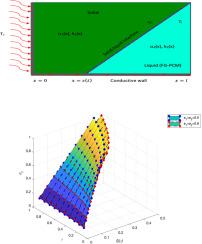具有功能梯度相变材料的两相移动边界问题的Gegenbauer小波方法
IF 5.4
3区 工程技术
Q2 ENERGY & FUELS
引用次数: 0
摘要
在过去的几十年里,功能梯度相变材料(FG-PCMs)已广泛应用于药物、合金铸造、热控制和工程显微组织。虽然FG-PCMs的单相结构特性已经得到了广泛的研究,但对于两相固液过程中FG-PCMs的建模和模拟还不够,这也是本研究的重点。为了模拟研究,考虑了一个结构良好、空间变化的导热系数和热扩散系数分布函数,克服了在固液相变过程中选择任意分布函数的局限性。采用基于配点法的Gegenbauer小波对本研究进行了仿真。所得到的数值结果在特定条件下精确收敛于所建立的Stefan解,并通过已知的有限差分法(FDM)收敛于完整的模型场景。空间可变的导热系数和热扩散系数分布函数对FG-PCM的凝固速率有显著影响。此外,与其他相的等或不等分布函数相比,固体中导热系数和热扩散系数的空间可变分布函数表现出较低的温度,从而增强了固液界面。导热系数和热扩散系数的二次表示提供了最快速的凝固速率。本文章由计算机程序翻译,如有差异,请以英文原文为准。

Gegenbauer wavelet approach of a two-phase moving boundary problem with functionally graded phase change material
Over the past few decades, functionally graded phase change materials (FG-PCMs) have been extensively employed in drugs, alloy casting, thermal control, and engineered microstructures. Although FG-PCMs have been extensively studied for their structural properties in a single phase, the modeling and simulations of FG-PMs in two-phase solid–liquid processes are insufficient and are the focus of this study. To simulate the study, a well-structured, spatially varying distribution function for thermal conductivity and thermal diffusivity is considered, which overcomes the limitations for choosing arbitrary distribution functions in solid–liquid phase change processes. Gegenbauer wavelet, based on the collocation method, is employed to carry out the simulations of the current study. The numerical results obtained accurately converge to the established Stefan solution under specific conditions, as well as to the complete model scenario via the known finite-difference method (FDM). Spatially variable thermal conductivity and thermal diffusivity distribution functions significantly influence the solidification rate of FG-PCM. Furthermore, the spatially variable distribution functions of thermal conductivity and thermal diffusivity in solids exhibit lower temperatures, hence enhancing the solid–liquid interface compared to equal or unequal distribution functions of other phases. The quadratic representation of thermal conductivity and thermal diffusivity provides the most rapid solidification rate.
求助全文
通过发布文献求助,成功后即可免费获取论文全文。
去求助
来源期刊

Thermal Science and Engineering Progress
Chemical Engineering-Fluid Flow and Transfer Processes
CiteScore
7.20
自引率
10.40%
发文量
327
审稿时长
41 days
期刊介绍:
Thermal Science and Engineering Progress (TSEP) publishes original, high-quality research articles that span activities ranging from fundamental scientific research and discussion of the more controversial thermodynamic theories, to developments in thermal engineering that are in many instances examples of the way scientists and engineers are addressing the challenges facing a growing population – smart cities and global warming – maximising thermodynamic efficiencies and minimising all heat losses. It is intended that these will be of current relevance and interest to industry, academia and other practitioners. It is evident that many specialised journals in thermal and, to some extent, in fluid disciplines tend to focus on topics that can be classified as fundamental in nature, or are ‘applied’ and near-market. Thermal Science and Engineering Progress will bridge the gap between these two areas, allowing authors to make an easy choice, should they or a journal editor feel that their papers are ‘out of scope’ when considering other journals. The range of topics covered by Thermal Science and Engineering Progress addresses the rapid rate of development being made in thermal transfer processes as they affect traditional fields, and important growth in the topical research areas of aerospace, thermal biological and medical systems, electronics and nano-technologies, renewable energy systems, food production (including agriculture), and the need to minimise man-made thermal impacts on climate change. Review articles on appropriate topics for TSEP are encouraged, although until TSEP is fully established, these will be limited in number. Before submitting such articles, please contact one of the Editors, or a member of the Editorial Advisory Board with an outline of your proposal and your expertise in the area of your review.
 求助内容:
求助内容: 应助结果提醒方式:
应助结果提醒方式:


